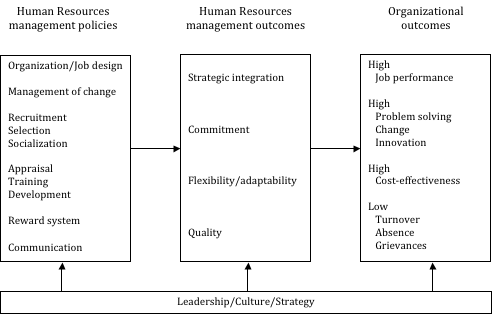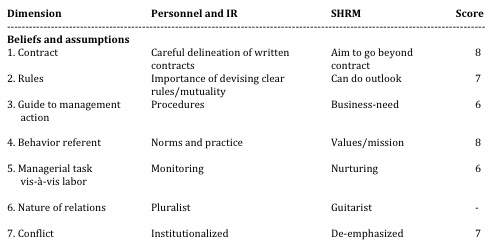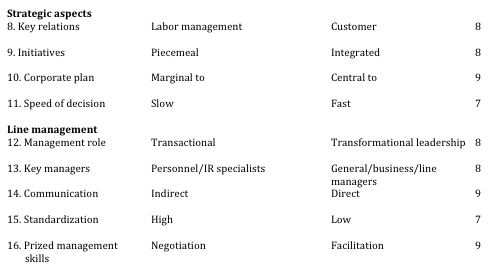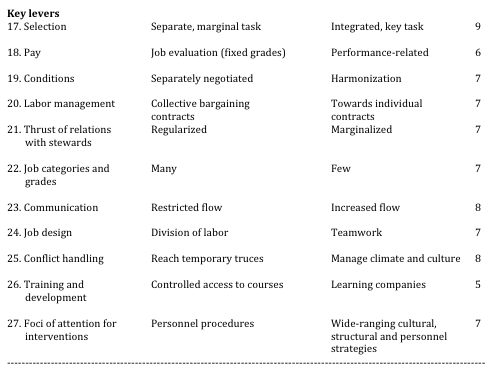A. The strategic approach of Human Resources Management
Introduction
Before any analysis is made it would be probably recommended to establish a common understanding of what Strategic Human Resources Management (SHRM) means and refers to. If we take the four words in SHRM and describe them one by one then we should understand that the “Human” factor relates to the individual employees in an organization (their skills and competencies, their needs and aspirations, their unique way of contributing to achieving the organization’s objectives). Than the word “Resources” tells us the fact that employees should be considered as assets/investment rather than costs (they represent value for an organization) and should be treated in a “Strategic” manner, which means to look at these assets from a strategic perspective (long term view). Finally the last word “Management” tells us that in order for these resources to be effective and efficient for the organization they have to be managed properly. That means to use a dedicated set of activities, approaches, policies and practices that will allow individuals to bring their maximum contribution to the organization.
A model of SHRM
We leave in a world of profound changes in all aspects of our lives. One of the fields that is in a continuous and dramatic change is the business arena that is characterized nowadays by:
- a globalization process marked by mergers and acquisitions;
- rapid developments in technology, especially in IT and communication fields;
- a tough competition in all business areas;
- major political and economic influences, etc.
All these factors make it difficult for an organization to keep or enhance its position in the market place, in other words to gain a sustainable competitive advantage.
In the past, simply having access to the necessary raw materials and technologies, being able to achieve economies of scale or better control over the supply chain would have provided the desired advantage over the competition. Nowadays it is largely recognized that the human resources, the intellectual capital of an organization represents one of the few resources for competitive advantage. The employees are the ones that make a difference, which can differentiate one organization’s products and services from another’s.
It is also recognized that the management of the human resources is of a strategic nature, that means that long term consideration should be given to acquiring, developing and retaining capable and committed employees. The responsibility of managing the HR lies not only with the HR/Personnel specialists but also with all managers, at all levels. Last but not least, the key levers (the policies, practices, approaches, etc.) must be internally integrated (coherent and converging to the same objectives) and externally integrated (with the external environment and business objectives of the organization). These are the reasons for the fact that managing the HR becomes of a paramount importance for organizations.
We can distinguish several approaches to SHRM. One way is to prescribe the way the employment relationships should be conducted. Another way is to describe the way things are actually happening within organizations. Yet another way is to use conceptual models which aim to clarify the connection between specific HR management policies and subsequent organizational outcomes.
One of such models was developed by David Guest in 1992 (see Figure 1). This model suggests that if the key levers in the left column are properly used, then the four HR management outcomes listed in the center are delivered, and in the case that all these four outcomes are present they can lead to the organizational outcomes listed in the right column provided that the leadership, culture and strategy factors are present and sustain the HR system.

Figure 1: A model of HRM, David Guest, 1992
SHRM and organizational performance
The question for a model like the one presented above is how is it working in practice, what are the results of such an approach? Empirical evidence suggests that the SHRM does influence the organization performance through:
- HR planning;
- recruitment and selection;
- job design;
- communication and involvement;
- reward system;
- training and development;
- teamwork.
In order to achieve an improvement in organization performance the above HR polices and practices have to be internally consistent and to support each other. There is also a need for these practices to be externally integrated with the business and environment and overall business strategy.
In order to measure the performance of an organization it is necessary to consider all the critical factors that determine the success of that organization and to avoid considering only one type of indicator (very often – financial results). Such other measures for organizational performance are:
- customer satisfaction;
- quality of products and services;
- performance of key processes;
- organizational culture/employees’ attitudes and behaviors.
All these measures can be put together into a balanced scorecard that provides an overview of the organization’s performance. In this way the managers at all levels within a company have the opportunity to include all these factors into their decisions.
Critical issues
When discussing about the benefits of SHRM we have to consider, however, the following critical factors:
- there is no assurance that SHRM delivers the expected outcomes (simply putting the practices in place will not deliver the expected results);
- the ultimate benefits depend very much on the context of the organization;
- even the term SHRM does not have the same meaning for everybody;
- implementing good HR practices and getting the rewards is a long process;
- a lot of work, patience, attention and care have to be dedicated to ensure the proper implementation and the delivery of the results;
- financial costs have to be considered as well, as many HR practices come in contradiction with short term approaches of costs reduction.
B. A case study on HRM
Company evaluation
In order to support our discussion about SHRM I will take the example of a company in the FMCG field that I shall call Company X. From an organizational point of view the company has three distinct plants and a support Headquarters with a strong emphasis on decentralization, but with a good coordination from the center.
To analyze the extend to which HRM is strategic in this organization, I will use the model proposed by John Storey in 1992. This model describes the approach of an organization on four main HR areas: beliefs and assumptions, strategic aspects, the role of the line management and the key HR levers. In order to evaluate each dimension in these areas I will use a scale from 1 to 10 with score 1 pointing to the description in the left side of the table and score 10 pointing to the description in the right side of the table (see bellow).



If we look at the results we may conclude that HRM is intended to be strategic but the actual execution might lag behind the intentions. Indeed the HR Managers are part of the management teams in every plant and in the Headquarters and are able to influence and support business decisions that have an impact on the human resources of the organization.
Some of the dimensions that seem to be more oriented towards Personnel and Industrial Relations practices can be explained by the followings:
- the organization is young (5 years) with the third plant being built 4 years ago and the HQ function evolving during the last 3 years in a support team for all areas of the business;
- decentralization is seen as a way to manage three different geographical territories, but because of the need for internal integration and coherence of the actions some dimensions had to become more rigid/procedural (job categories and grades, method of pay, employment contracts, etc.);
- dramatic negative changes in the overall country economic climate and in the market place. These factors had an important impact on the profitability of the business and on the attention and resources that were involved in acquiring and developing the company HR.
The company is somewhere between the best practice approach and the best-fit approach to HRM. The best practice approach is characterized by the definition and implementation of a range of HR practices that are related to recruitment and selection, job design, performance evaluation, training and development, definition of career paths, etc. However a best fit approach is present as well, as from a strategic perspective the company had to respond (from the HR point of view) to many external influences and had to make sure that the changes in the HR field are aligned to the overall organizational/business changes. Internal integration was intended to be achieved through the introduction of practices and systems that were designed to complement and support each other. And even an external integration was achieved if we take into account the massive transfer of knowledge and support to and from the main distributors of the company.
C. Recommendations for the development of SHRM in this organization
It would be interesting for this exercise to point out the concept of the Resource Based View in the form explained by Frank Mueller: the human resources are scarce, valuable, firm specific and difficult to imitate resources that can contribute significantly to the achievement of competitive advantage and from this point of view they should be regarded as strategic assets. According to Mueller the development of the strategic human resources:
- is a slow, incremental, evolutionary process that requires patience;
- is facilitated by persistent intentions and actions;
- is based on the process of skill formation which is not only a merely training/developing process;
- is based on “spontaneous co-operation” and team-work;
- is effective if HR work in concert with other resources.
Company X should pay attention to all five characteristics presented above. This means to have a vision regarding the role of the human resources in supporting and facilitating the company’s strategy, to integrate this vision in the overall vision and mission of the organization, to devise initiatives that will translate this vision into reality and to be persistent in its strategic HR approach.
HR should be considered in conjunction with other strategic assets like: trade marks, brand image, patents, reputation, good will, business and technology know-how, etc. Bundling all these resources together and exploiting them in a distinct manner will allow the organization to build distinctive capabilities that in turn will constitute the base for organization’s competitiveness in the market place.
Company X should identify the resources mobility barriers that would make it unique and impossible to imitate by its competitors and should exploit these barriers to build and strengthen its competitive advantage.
In practice this means to:
- continue to invest in good HR systems and practices and to not cease to develop its HR even in periods when the conditions in the market place are not so favorable;
- stimulate and enhance the role of line managers in developing the company HR through providing them a true understanding of the importance of the role employees play in achieving the company objectives;
- better integrate the various policies and practices both with the strategic objectives of the organization and among themselves;
- to consider the ethical aspects involved in SHRM, both for internal consistency and integrity and for the external image of the organization;
- although various key business indicators are defined to help managing the performance of the organization, it would be useful to define a single set of critical business measures that would provide an overall picture of the company’s performance. This set of indicators (that will form a balanced scorecard) together with their values should be communicated to all managers and employees making them accountable for the achievement of the company objectives;
- strive to build a strong organizational culture that is based on values and beliefs that are commonly shared by the company stakeholders (shareholders, customers, management, employees, etc.). Although this is a difficult process, a persistent and continuous effort towards communicating the values, motivating the employees, obtaining their commitment for achieving the long-term objectives of the company would help building the desired organizational culture.
References
(1) Guest, D. (1992) “Employee commitment and control” in Hartley, J. and Sthephenson, G., Employment Relations, Oxford, Blackwell
(2) Storey, J. (1992) Developments in the Management of Human Resources, Oxford, Blackwell
(3) Mueller, F. (1998) “Human Resources as Strategic Assets: An Evolutionary Resource-based Theory” in Mabey, C., Salaman, G. and Storey, J., Strategic Human Resource Management, London, Sage Publications
Author: Dan Humelnicu, MBA – Managing Partner, ROSS Consultants, 2003






